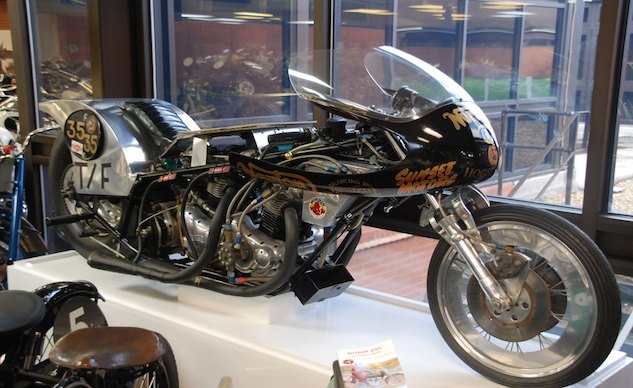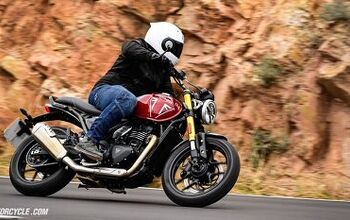Top 10 Neat Bikes At The British National Motorcycle Museum
Do you remember how boring and mundane going to a museum was as a kid? It was practically torture, but any excuse to get out of school was better than the alternative. It’s funny how things change as you get older. You start to appreciate and become more interested by the way things were, how previous generations lived compared to what we’ve grown accustomed to now. Shit, you could actually learn something.
A bunch of us moto-journo types were given a tour of the British National Motorcycle Museum, which houses more than 1,000 immaculately restored motorcycles. After the tour wrapped up, we were told we had 10 minutes to have a look around for ourselves before the bus left. Only 10 minutes and over 1,000 motorcycles, that’s like… less than two seconds to nerd out on each bike, man – that’s not fair! Well, such is life, but here are 10 motorcycles, in no particular order, that happened to catch my eye while I was there. Like me, maybe you can learn something too.
Enjoy.
1. 1942 125cc Royal Enfield WD/RE “Flying Flea”
Royal Enfield’s best known military machine was the little two-stroke that was supplied for airborne forces’ use and fondly named the “Flying Flea” during WWII. The little bike was produced in military guise from 1942-1944 and was mainly used by paratroopers. It was enclosed in a tubular steel frame and dropped out of aircraft with a parachute attached. On the ground, a soldier could release it from the frame and be on the move within minutes. One of the light machine’s benefits was that it could be picked up and carried over obstacles. One neat feature of the “Flying Flea” was its girder front end that was actually ‘sprung’ by thick rubber bands.
2. 1912 848cc Wilkinson TMC Series V
Luxury on two wheels. The Wilkinson TMC (Touring Motor Cycle) Series V was thought of and built more to be like a two-wheeled-car than a traditional motorcycle. It features an 848cc water-cooled motor with a radiator mounted in the airstream behind the front wheel. A Wilkinson rider needed a fair bit of practice to get used to the various controls: The pedal on the left footboard operates the clutch, while the two on the right bring on two separate sets of rear brake shoes. Engine speed is controlled by juggling the air and fuel levers on the right handlebar, a gear-change knob lies just in front of the seat, and the plunger with a sight-glass ahead of that is for pumping oil to the engine. At least the speedometer is easy to see… It is said that no more than 250 of these were ever built and experts say there are only six that are known to still exist.
3. 1915 Royal Enfield 675cc Three-Cylinder Two-Stroke Prototype
This 675cc Royal Enfield motor prototype is believed to be the first-ever built three-cylinder two-stroke. It features three 225cc engines meshed together, and the whole motor is fed by a single carburetor mounted to a manifold directing air and fuel to the cylinders. The motorcycle was said to have a top speed of 50 mph but was discontinued because the fuel/oil consumption was only 35 mpg, a figure regarded as excessive in those days… 35 mpg doesn’t sound that bad to me, even a century later!
4. 1939 Brough Superior 1000cc Golden Dream
The Brough Superior Golden Dream is one of the few dreams ever to get beyond the realm of fantasy for George Brough, a native of Nottingham, England. The engine was a four-cylinder in the form of two horizontally opposed flat twins mounted one above the other and connected by geared camshafts. Kind of like an H on its side. With its distinctive gold finish, this was to be the ultimate Brough Superior, but production was stopped by the outbreak of War in 1939. Only five were ever made, unfortunately. Interesting to know, and a shame really, but what caught my eye was the exhaust. It appears that headers had cooling fins and the fishtail exhaust tips only allow a sliver of spent gasses to escape. An interesting and peculiar design, I thought. I also wish I took more pictures of it, but if you’re curious, just click here.
5. 1980 Quasar 848cc
The Quasar was a semi-enclosed, feet-forward motorcycle, created by Malcolm Newell and Ken Leaman during the 1970s . It used an 848cc engine built by Reliant Motors and was purportedly capable of cruising at 80-90 mph and exceeding 100 mph in favorable conditions. The front of the bike had a laminated glass windscreen with wipers and a heater. The semi-enclosed ‘cockpit’ was said to create big blind spots where the rider would have to stick his head out to see more clearly. Only 21 of these Quasars were built with Reliant motors, so it was pretty neat to get to sit in one.
6. 1922 Royal Enfield 976cc V-Twin Front Brake
This 976cc V-Twin was said to be made for the family man because it was comfortable, powerful, moderately priced and capable of good road performance. It was claimed to make between six and eight horsepower and it only had one brake to slow down all that vicious power, which was operated by the rider’s left foot. The pedal pulled a cable that then relied on leverage to push the V-shaped brake shoe into a giant groove that followed the perimeter of the wheel. Simple and effective enough, I suppose.
7. 1932 Brough Superior Austin-Engineered Four
The Brough Superior Austin Four was a limited-production motorcycle that only ever saw 10 models built. It was revealed at the 1931 Olympia Motorcycle Show, a British motorcycle show in London. The machine is unique in its design, being powered by a modified 797cc, four-cylinder Austin Seven automobile engine and gearbox. A driveshaft emerges from the centerline of the motor and rather than design a new gearbox, George Brough had the inspiration to keep the central driveshaft and use a pair of closely coupled rear wheels driven by a central differential. This three-wheeled design was legally considered a motorcycle by British standards, as the wheels were less than 24 inches apart. I’d be super curious to see how this thing handled.
8. Hand-painted Pinstriping on Royal Enfield Gas Tanks and Rims
Royal Enfield gas tanks and wheels, we were told, have always been pinstriped by hand since as far back as 1932 on all of the company’s models. I have to do a little bit more research to see if the hand-painting dates back even further, but nonetheless, pinstriping is no joke! I can’t imagine how steady a painter’s hand must be to accomplish such a feat and not screw it up. Royal Enfield is en route to building more than 825,000 bikes this year, and plans on making 950,000 bikes next year – that’s a whole lot of pinstriping. Check out this video of a Royal Enfield worker laying down the lines on a new fuel tank.
9. “Pegasus-Norton” Top-Fuel Drag Bike
Powered by two Norton 828cc engine with two Shorrock superchargers, Pegasus was designed, built and ridden by Brits Derek Shinn and Ian Messenger. The bike competed widely, capturing many victories and awards at events throughout Europe before making its final appearance in the early 1980s. With its two-speed transmission and power output of approximately 350 hp, Pegasus ran on a spicy mixture of 75% nitromethane and 25% methanol, burning 1.5 gallons on a quarter-mile run. During its race career, Pegasus achieved a fastest standing start quarter-mile time of 8.39 seconds with a terminal speed of 170 mph over the same distance. Not too shabby…
10. 1914-1918 Clyno Machine Gun Sidecar 750cc V-Twin
Aggressive as it looks, you can probably imagine this machine roaring into action with its Vickers machine gun blazing, but it wasn’t like that in actual service during WWI. With the war-torn and shell-battered terrain of the Western Front, a sidecar outfit was not a stable platform for a machine gun. Most often it was lifted from the sidecar chassis and set up on its own tripod mount and hopefully behind some natural cover. The motorcycle the sidecar/machine gun combo is attached to is basically the 1914 Clyno civilian model with a 750cc engine and a three-speed gearbox and clutch, which looks hefty enough for a tractor.
More by Brent Jaswinski


















































Comments
Join the conversation
So can England claim that the 1912 848cc Wilkinson TMC Series V is the first cruiser ever built? Floor boards, pulled back handle bars , big comfortable seat in a reclined position?
Re pinstriping: BMWs were always hand-pinstriped, well into the 80s and, possibly, the 90s. FWIW, my 1977 R100RS, which had been one of the personal bikes of former BMW racer and, later, Chico, CA BMW shop owner Ozzie Auer, had pinstriping on the RIMS of that bike's wire wheels, as well as on its iconic - and incredibly effective - bodywork.
Selling that bike was, of course, one of the absolutely dumbest things I ever did.